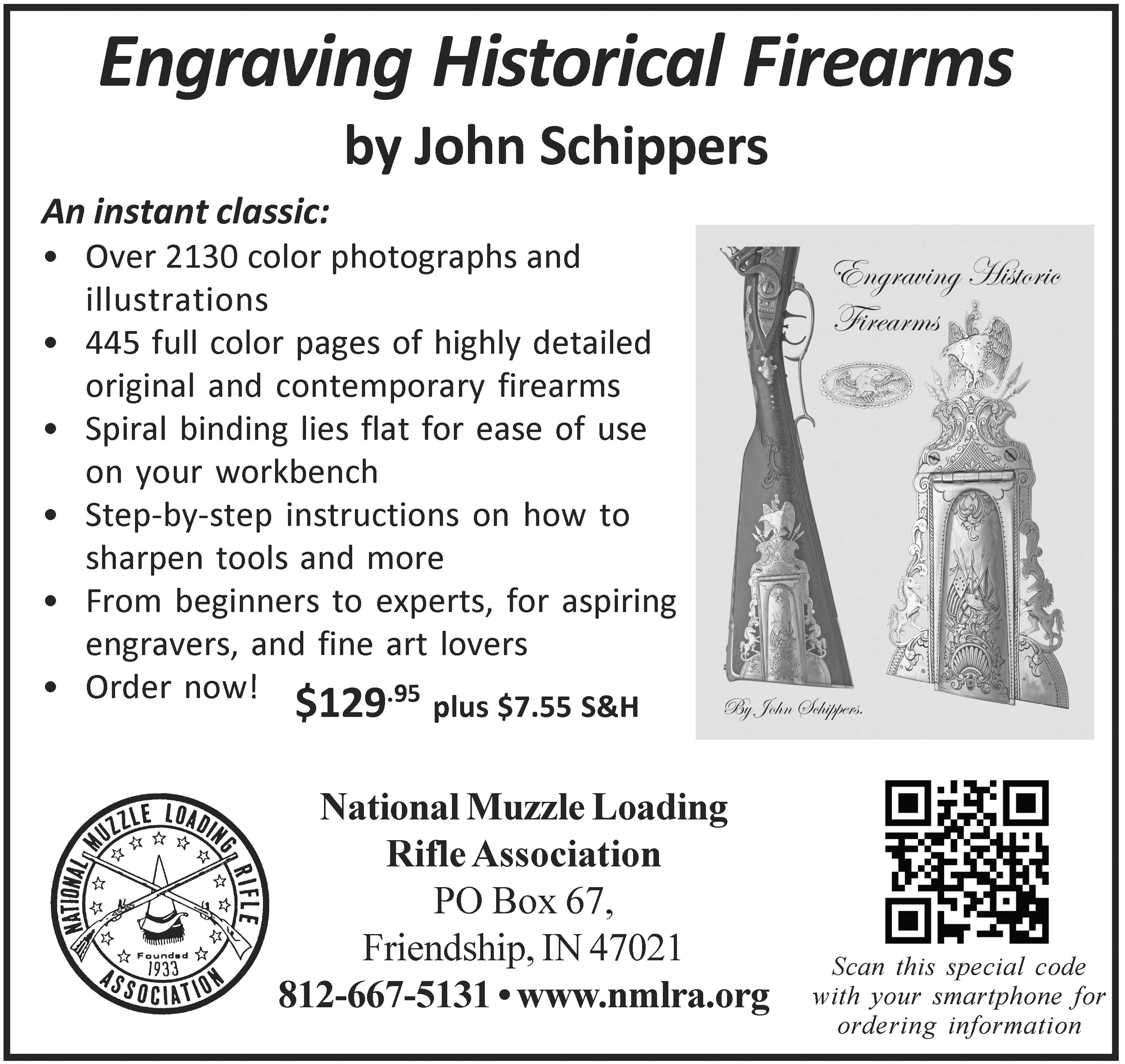by James C. Fulmer | Past President NMLRA
“He who once hits will be ever shooting. This is literally true, for I have known many a foolish fellow spend much time and money shooting to no purpose because he happened one day to hit a turkey by chance.
—1811 The Old Farmer’s Almanac
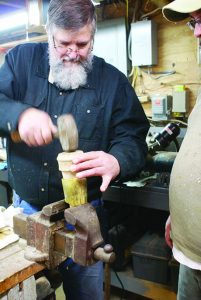
Author driving softened horn on form.
There will be many great muzzleloading events going on this coming year. There will be trade fairs, re-enactments, and muzzleloading shoots. Most of these will have competitions that will need prizes. Prizes no matter the size or shape are appreciated by everybody who wins them. Competitors love prizes.
I have been running muzzleloading rifle matches for over 40 years now and have always done my best to have great prizes for these events because I want to keep a person interested in shooting. What was written in the 1811 Farmer’s Almanac is still true today. One of my favorite competitions that I put on is the closest shot to the X-center out of three shots. Like the shooter in 1811, by chance a shooter can get one center shot and he will forever be shooting to get better to be able to win again.
At the National Muzzle Loading Rifle Association’s Annual Rifle Frolic, this year on Oct. 6-8, held in conjunction with the 18th Century Marketfaire at Fort Roberdeau in Pennsylvania, over 100 prizes will be given out. It is only through the generosity of many, many, people that this can happen—from large corporations, family owned muzzleloading shops and individuals. The event is into its fifth year and I can’t thank everybody enough for making the event happen. There were over 100 competitors last year and I hope we will continue to grow.
John DeWalt is one of the many people who have supported the Rifle Frolic through donations of beautiful scrimshawed powder horns. He along with many others from the Honorable Company of Horners supported this event with donations. Roland Cadle and Art DeCamp each donated powder horns for two of the long range matches (we shoot out to 280 yards with patch round ball). The winner’s name is placed on the horn each year. To win the horn you must win the best out of five years before it is yours for the keeping. If nobody wins it three times in five years the previous winners’ names will be placed in a hat for a drawing for the horn, so if you won two times you could have two chances out five to win. Don Blazier did not let it go that far and has already won the Roland Cadle powder horn that was the prize for the Tim Murphy Match by winning it three straight years in a row. Good shooting, Don!
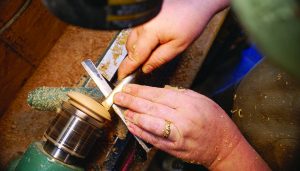
Turning dome lid on Lathe.
John DeWalt, who is a Master Horner, came to me last year with a proposal for prizes. I am a journeyman tool and die maker and journeyman machinist. John knew this and said he would teach me how to make horn boxes. That way you can make them yourself and have nice little prizes to give away at the event. I thought a horn box would be a great prize and John assured me they are easy to make.
Horn boxes come in all sizes and shapes, generally round and can be small to large. The small ones I have seen are used for carrying greased shooting patches in one’s shooting bag and scale up to really large ones set on the shooting bench where I have seen shooters dip shot out of for shooting trap with their smoothbores.
Getting together with John was always hard and we talked about it for over a year before it happened. The horn boxes we decided to make were about the perfect size for placing rings, jewelry, loose change, or any other of the whatnot’s you have in your pocket. My wife Linda came along to take pictures because it’s true that one picture is worth a thousand words.
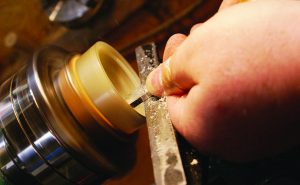
Boring inside of box.
Please know that I work in steel, not horn and wood; and I had never turned on a wood lathe in my life. John showed me how the wood lathe worked and how to hold the chisel and the first project was turning a 4-by-4 into a round mandrel to press the horn on. That went pretty easy. I turned a taper about the same natural taper of the horn.
Heating the horn in a deep fryer filled with lard to 325 – 350F was actually easier than I thought it would be. All the powder horns I have ever made, three to be exact, were done by forming the plug to the natural shape of the horn and epoxying it in for a tight seal.
John was so proud of me when I turned the mandrel on the lathe, heated the horn up, drove it on the mandrel, turned the outside of the horn, polished it till it sparkled, then faced off the ends all great. Then I took it off of the mandrel placed it in the lathe to bore the inside diameter. It was really pretty easy under the watchful eye of a master. But then it happened.
Boring in a wood lathe I need a little more, well, maybe a lot more practice. John showed me about two passes through the horn inside and he got a phone call and said you try it. He stepped outside. Up to this point I thought this was easy; then I put my first gouge in it. I can clean that up I thought. Oops, gouged it again in a different spot and still have the original gouge. I looked back over my shoulder and “&^$%,” I put a third gouge in another spot.
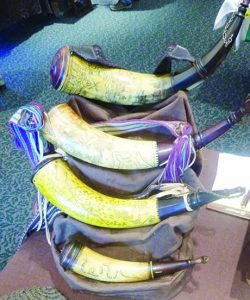
John DeWalt’s powder horns on display.
John came back and asked, “How you are doing?
I covered the opening of the horn with my hand and said, “Good, good.”
“OK, what did you do?” John looked into the horn and said, “You messed that up good. You are one of the faster messier uppers I have ever seen.”
There is a reason he’s a Master Horner; he was able to correct my gouges and we continued on. I will have to make a few more horn boxes before I can start giving them away, but it is an easy enough project. Hopefully, I will have mastered the process long before October. We’ll see.
Thanks John.

